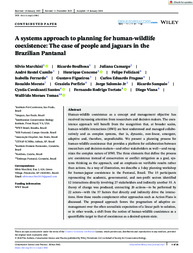A systems approach to planning for human-wildlife coexistence: The case of people and jaguars in the Brazilian Pantanal.
A systems approach to planning for human-wildlife coexistence: The case of people and jaguars in the Brazilian Pantanal.
Author(s): MARCHINI, S.; BOULHOSA, R.; CAMARGO, J.; CAMILO, A. R.; CONCONE, H.; FELICIANI, F.; FERRARDO, I.; FIGUEIROA, G.; FRAGOSO, C. E.; MORATO, R.; PORFÍRIO, G.; SALOMÃO JUNIOR, J.; SAMPAIO, R.; SANTOS, C. C.; TORTATO, F. R.; VIANA, D.; TOMAS, W. M.
Summary: Human-wildlife coexistence as a concept and management objective has received increasing attention from researchers and decision makers. The coexistence approach will benefit from the recognition that, at broader scales, human-wildlife interactions (HWI) are best understood and managed collaboratively and as complex systems, that is, dynamic, non-linear, emergent, adaptive and, therefore, unpredictable. We present a planning process for human-wildlife coexistence that provides a platform for collaboration between researchers and decision-makers—and other stakeholders as well—and recognizes the complex nature of HWI. The three elements that define the process are: coexistence instead of conservation or conflict mitigation as a goal, systems thinking as the approach, and an emphasis on verifiable results rather than actions. As a way of illustration, we describe a 3-day planning workshop for human-jaguar coexistence in the Pantanal, Brazil. The 15 participants representing the academic, governmental, and non-profit sectors identified 12 interactions directly involving 27 stakeholders and indirectly another 55. A theory of change was produced, connecting 20 actions—to be performed by 22 actors—with the 57 factors that directly and indirectly drive the interactions. How these results complement other approaches such as Action Plans is discussed. The proposed approach favors the pragmatism of adaptive co-management over the often unrealistic expectation of a linear path to solution, or in other words, a shift from the notion of human-wildlife coexistence as a quantifiable target to that of coexistence as a desired system state.
Publication year: 2024
Types of publication: Journal article
Unit: Embrapa Pantanal
Observation
Some of Embrapa's publications are published as ePub files. To read them, use or download one of the following free software options to your computer or mobile device. Android: Google Play Books; IOS: iBooks; Windows and Linux: Calibre.
Access other publications
Access the Agricultural Research Database (BDPA) to consult Embrapa's full library collection and records.
Visit Embrapa Bookstore to purchase books and other publications sold by Embrapa.

